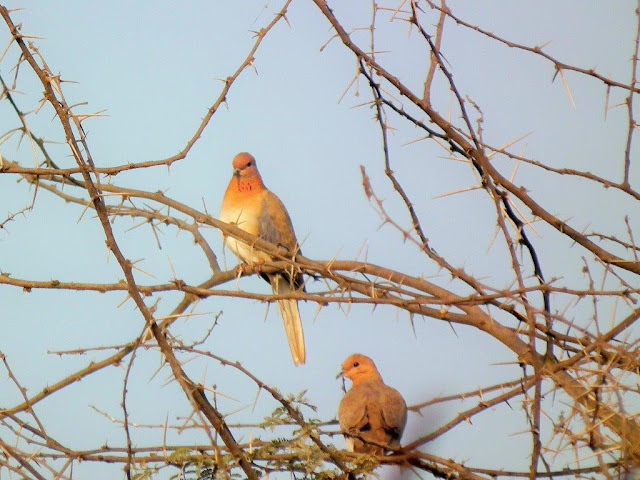Bird Watching Towers
As mentioned in my earlier post, the bird watching towers offer a good view, but considering how far away they are located from the water body and the islands, spotting of aquatic birds without binoculars or spotting scopes is difficult. Nevertheless, birds such as jacanas and moorhens can be easily be seen from the towers, foraging for food on the densely growing water plants.
The vegetation in the vicinity is mainly thorny acacia, interspersed with neem, peepul and other species. These trees alongside the tall grass and reeds form an ideal habitat for all types of terrestrial birds, such as green bee-eaters, weaver birds, munias, prinias, shrikes and the more common doves. One can hear the prinias almost everywhere while exploring the area, although the vegetation makes it difficult to snap a clear picture – if you have a digital camera with a not-so-fast enough processor, although this is quite a simple task with the newer camera or a DSLR.
During the winter months, migratory swallows can be spotted, perched on electricity cables, getting ready to fly back to cooler climes.
We also spotted a lone red headed ibis foraging for grain seeds, insects and small lizards in the open fields adjoining the lake.
Farms and Fields
There are farms and fields in close proximity to the sanctuary, planted with various types of vegetables and grains like paddy, chana (chickpeas), wheat, sugarcane, onion, cabbage. Here, one can spot drongos, robins and egrets. Small dhaba-type restaurants near the entry/exit road offer a variety of regional snacks if you are hungry or thirsty after spending the day wandering through the sanctuary.
Time Spent in Nature is Time Well Spent
For birdwatchers and environmentalists, a visit to the sanctuary is definitely time well-spent. For city-dwellers who prefer shopping malls to roughing it out in the sanctuary, this is something they must experience to understand and appreciate the wonder of nature.
Avoid Littering
As always, it is expected that as visitors, we do not litter the area and do not throw leftover food stuff in the sanctuary, as this can be detrimental to the local the ecosystem and lead to entry of pests into the area.
Northern Shoveller: Male and female
Pheasant-tailed Jacana
Little Brown Dove
Marathi: Parawa
It is small myna-sized bird, slim, brown in colour above, with whitish abdomen. Outer edges of its wings are bluish grey. Below its neck is a pattern of black spots which makes it easy to identify. It is swift in flight with quick and sharp movement of wings. Usually seen in pairs in dry, thorny regions in the vicinity of farm buildings.
Eurasian Wigeon
The males have a chestnut head and buff-brown colored forehead, grey body, black tipped wings and black tail portion. Females are light brown and grey. It is a winter migrant to Northern and Western India (also Africa) from Europe and can be found in wet marsh lands and shallow water bodies.
Cotton Teal (Cotton Pygmy Goose)
This is a resident aquatic species, found all over India. Males have a dark-brown forehead and a black collar at the base of the neck while the back and wings are brown and dark green. Females do not sport dark colours. A feature which differentiates them is dark stripe running through the eyes in females. It is much smaller than the normal ducks.
Cotton teals are among the several species which have shown a very steep decline in numbers due to drastic reduction in wetland habitats and hunting for meat, which is sold as exotic food in road-side dhabas. The others include quails and partridges (teetar-baater).
To all readers of this blog, it is sincerely appealed that they make all efforts to avoid eating at such dhabas, thus reducing exploitation wildlife for food. Keep in mind that the wildlife is hunted in an extremely cruel manner, using mechanical contraptions and snares that cause untold misery to birds and animals.
Rufuousbacked Shrike
Commonly found all over the country, in dry, open forests, often perched on telephone or electricity cables. It has a grey forehead and a black band running across the eyes and a strong, hooked beak. Abdomen is rust colored (rufous). Both sexes are alike.
Common Swallow / Striated Swallow
Winter visitors to India from the cold European regions.
Green Bee-eater
Jungle Myna
Purple Moorhen
Thank you for reading. If you need more information, you may add your comments or queries in the section below.
Take nothing but memories, leave nothing but footprints." -Chief Seattle
















.jpg)
.jpg)


.jpg)

